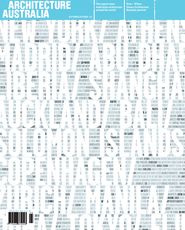“Between the intention of the author (very difficult to find out and frequently irrelevant for the interpretation of the text) and the intention of the interpreter who …. simply ‘beats the text into a shape that will serve for his purpose; there is a th
Architecture Australia is committed to a general policy of independent peer review. We work hard to commission articulate, thoughtful writers who will, we think, have something productive and interesting to say, both about the project in question and about related broader issues. We select writers based on their experience and expertise, but we never know quite what a writer will say or how they will frame the work – this is one of the strengths of this approach. On the whole this works well, and we publish many of Australia’s best architectural writers and thinkers in conjunction with the country’s best architects.
However, in this issue we have taken a different approach, we asked architects to briefly discuss their projects from their own perspective, in response to a set of questions posed by us. This is a result of the thematic concerns of this issue – export – and of the pragmatic constraints specific to it. However, it also opens up the role of intention in the reception and interpretation of architectural works – something I recently considered in another context (a paper with Paul Walker for the Writing Architecture symposium convened by Naomi Stead), and which I think is worth considering as we think about how to present and interpret works.
“Intention” is complex and problematic. It brings in its wake the spectre of the architect as singular (male) genius, which, despite having been deconstructed over and over again for many decades, and regardless of all the contemporary avowals of collaborative practice, remains strong in architecture. Of course, this is not limited to our discipline. It is now forty years since Barthes, Foucault et al. proclaimed the death of the author, yet “authors” still have significant traction in most fields of creative endeavour. The death of the author heralded the birth of the critic, and the privileging of interpretation over intention in the reception of a creative work. This raised another spectre – that of “over-interpretation”, authorial intention’s unruly other.
Cliches about architectural writing reflect this dichotomy. On the one hand, writing is often denigrated as “puff” – tame writers telling happy stories of what the architect wanted to do and how they did it (successfully). On the other, reviews that disregard the architect’s intention to pursue other agendas are derided as arcane and jargon-ridden. Most architectural writing is in fact more sophisticated than either of these tired cliches. Nonetheless, intention remains both difficult and interesting. This is partly because intention is always to some extent in doubt – we can never entirely know (or explain) the intent of either architect or writer, even if we are the architect or the writer. Likewise, the process of making a work, and its ongoing life, always exceed the conscious control or intent of any individual.
So, can we develop ideas about intention in architecture that operate beyond these paradigms, and that can consider the complexities of the life of a work in the world? I think there are clues to be found in Umberto Eco’s idea of “intention of the work”, which he locates in the encounter between a work and its interpreter, when that work is “read” in an “economic” way. The “intention of the work” can include the social, cultural, political and economic contexts in which it is made, and in which it is encountered. Shifting intention onto the work places limits on “over-interpretation”, while recognizing that the articulated intentions of the architect can never provide a complete account. This has great potential for opening up new avenues for writing on and representing the architectural project. We will continue to experiment.
Justine Clark, editor Architecture Australia.















